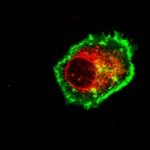Link to Pubmed [PMID] – 17006516
Nature 2006 Sep;443(7110):470-4
P-type ATPase pumps generate concentration gradients of cations across membranes in nearly all cells. They provide a polar transmembrane pathway, to which access is strictly controlled by coupled gates that are constrained to open alternately, thereby enabling thermodynamically uphill ion transport (for example, see ref. 1). Here we examine the ion pathway through the Na+,K+-ATPase, a representative P-type pump, after uncoupling its extra- and intracellular gates with the marine toxin palytoxin. We use small hydrophilic thiol-specific reagents as extracellular probes and we monitor their reactions, and the consequences, with cysteine residues introduced along the anticipated cation pathway through the pump. The distinct effects of differently charged reagents indicate that a wide outer vestibule penetrates deep into the Na+,K+-ATPase, where the pathway narrows and leads to a charge-selectivity filter. Acidic residues in this region, which are conserved to coordinate pumped ions, allow the approach of cations but exclude anions. Reversing the charge at just one of those positions converts the pathway from cation selective to anion selective. Close structural homology among the catalytic subunits of Ca2+-, Na+,K+- and H+,K+-ATPases argues that their extracytosolic cation exchange pathways all share these physical characteristics.
